Mushrooms are a fun and tasty addition to any meal, and they can be found all over the state of Ohio. Whether you’re looking for a portobello to top your burger with or some shiitake mushrooms for your stir-fry, there’s definitely a mushroom out there for you.
In Ohio, they can be found at farmers markets and grocery stores all over the state, so there’s no need to go far to get your hands on some delicious fungi.
However, if you’re feeling adventurous and want to go mushroom hunting in the wild, Ohio is the perfect place to do it. Below we’ll look at some common mushrooms in Ohio and how to identify them.
You must practice caution when hunting mushrooms. Only harvest fungi that you can properly identify or better hunt in the company of an experienced forager
Edible Mushrooms in Ohio
1. Morel Mushrooms in Ohio
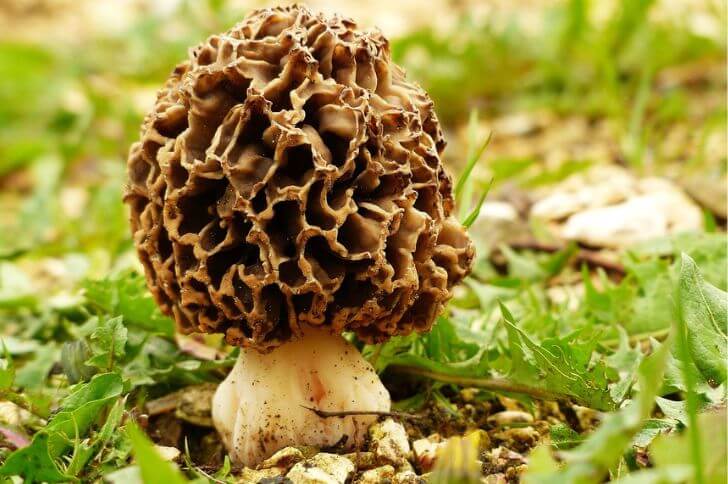
Morel mushrooms are a type of wild mushroom that can be found in many parts of North America including Ohio. They are found during months with warmer months, mostly spring.
These wild mushrooms first appear in Southern Ohio and gradually spread northwards. You can find them around creeks, parks and forests. You can check online if there is a mushroom club around your area which you can join and get some tips on specific areas to hunt for these mushrooms.
How can you identify the morel mushroom? Be on the look for a mushroom that resembles a honeycomb with a ridged cap. When you cut it open, you’ll notice it’s hollow from top to bottom. Morel mushrooms can be eaten raw or cooked, and they are said to have a rich, earthy flavor. They are also high in protein and other nutrients.
2. Ohio Giant puffball
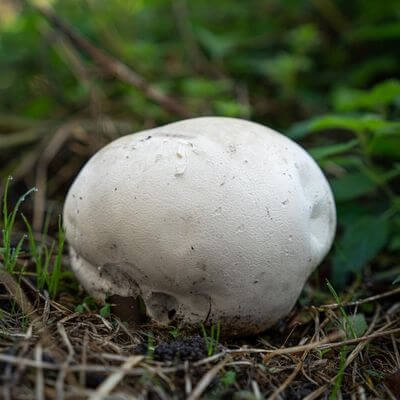
Giant Puffballs or the Calvatia gigantea is a large, edible mushroom. It is one of the most easily identified mushrooms, due to its large size and white color.
The Giant Puffball can reach up to 20 inches in diameter and 40 lb in weight. Can you eat giant puffball mushrooms? Yes. Are they tasty? Yes. What can you do with a giant puffball?
3. Red chanterelles

Chanterelles are a type of mushroom that can be found in a variety of colors, including red. Red chanterelles are a rare find, and they are most commonly found near the roots of trees.
They have a fruity, apricot-like flavor and a firm texture. Red chanterelles are best cooked lightly sautéed or grilled.
Related Read: Mushrooms in Georgia
4. Horse Mushrooms

Horse mushrooms are in season from summer to fall. They are easy to identify. Young mushrooms can be identified by the creamy white color. There may be some yellow staining on the cap.
Mature horse mushrooms are yellowish on the top of the cap while the gills are pinkish. These Ohio mushrooms are edible and can be used in recipes.
5. Flammulina velutipes
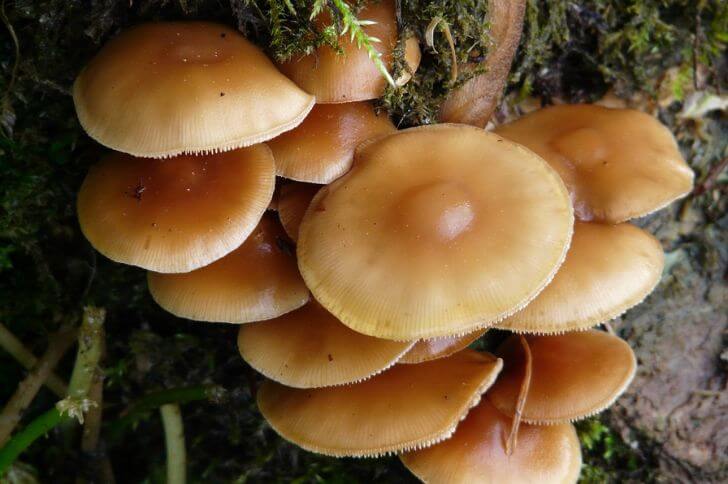
Once a rare mushroom found only in Japan, Flammulina velutipes is now found in parts of Ohio. It has a beautiful orange-brown cap and grows in clusters.
This edible mushroom has a rich, earthy flavor and a firm texture. It can be used in many dishes, including soups, stews, and risottos. F. velutipes is also good for grilling or roasting.
6. Parasol mushroom
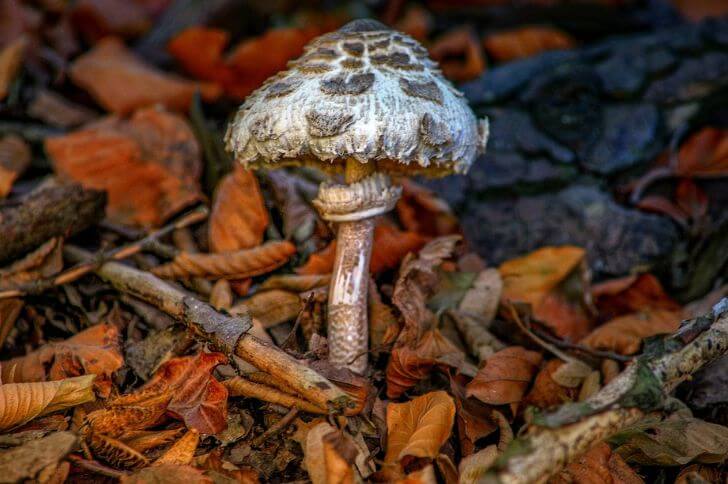
Parasol mushroom is a large, globe-shaped mushroom that grows in meadows and fields. The cap of the mushroom is white to cream-colored.
The gills of the mushroom are white, and the stem is white or light brown. The parasol mushroom is edible, most people will cook the cap only. Its stipe is inedible.
7. Slippery jack

Slippery jack is a mushroom that is a brown, conical shaped mushroom that typically grows on the ground in moist areas, such as under trees or near rivers and streams.
Slippery jack has a smooth, slimy cap and stem, which gives the mushroom its name. The mushroom is edible, but some people find it to be quite bitter.
Slippery jack can be cooked in a variety of ways, such as sautéed, grilled, or added to soup.
8. Gyromitra korfii (Snow Morel)

Gyromitra korfii is a species of fungus in the family Discinaceae. It typically grows on the deadwood of hardwoods, particularly oak trees.
It has a brown ‘cap’ that comes in different designs from lobed to broadly wrinkled. The cap can measure up to 4 inches. Its stem is whitish to tan. Cook the mushrooms thoroughly before eating.
9. Craterellus fallax

Craterellus fallax, better known as the Black Trumpet, is a small, black mushroom found throughout the northeastern United States.
It has a fruity, earthy flavor and can be used in both cooked and raw dishes. This mushroom is also highly prized by mushroom hunters for its rarity.
10. Blusher mushrooms
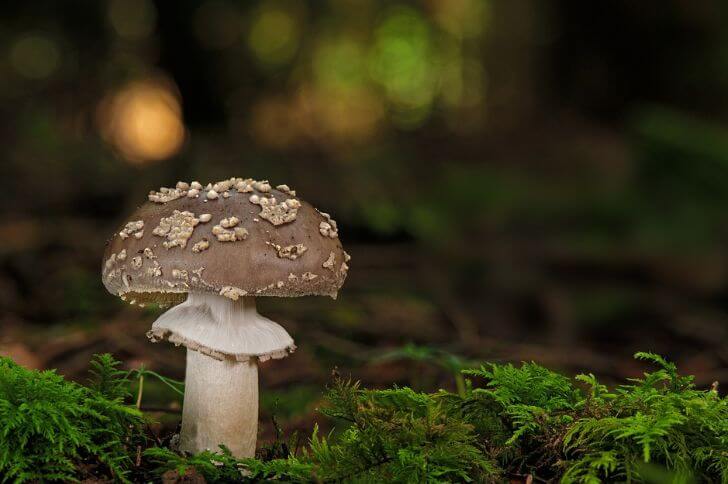
One of the most popular types of mushrooms found in markets across the globe is the blusher mushroom, also known scientifically as Amanita rubescens.
These mushrooms get their name from their tendency to blush or turn red when bruised, which is due to the presence of a compound called amanitin.
Blushers have a convex cap that measures up to 5.9 inches. You can identify it by checking the pinkish color around the end of its stem. These mushrooms are very tasty.
11. Smooth Chanterelle Mushroom in Ohio
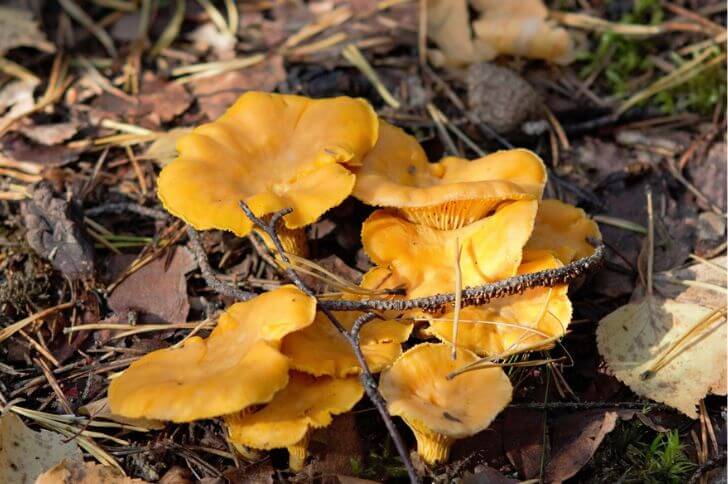
The smooth chanterelle (Cantharellus lateritius) is a species of fungus in the family Cantharellaceae. It is a common edible mushroom found in North America.
The mushroom has a concave cap measuring 0.8-3.5 inches in diameter, and a stem up to 4.7 inches high.
The color ranges from bright yellow or orange; the latter is more common. The taste is mildly fruity and somewhat peppery.
The smooth chanterelle grows on the ground singly or clustered together in groups, but not forming fairy rings as do some other chanterelle species.
12. Mycena leaiana (orange mycena)

Mycena leaiana is a small, white-gilled mushroom that typically grows on the ground in clusters.
It has a conical or bell-shaped cap that is 0.3-1.5 inches wide, and a slender stalk that is 1.2-2.8 inches long. The gills are white, and the spores are ellipsoid.
When younger, the mycena leaiana are mostly orange and grow in clusters. This mushroom is edible with no taste.
13. Wood Blewit
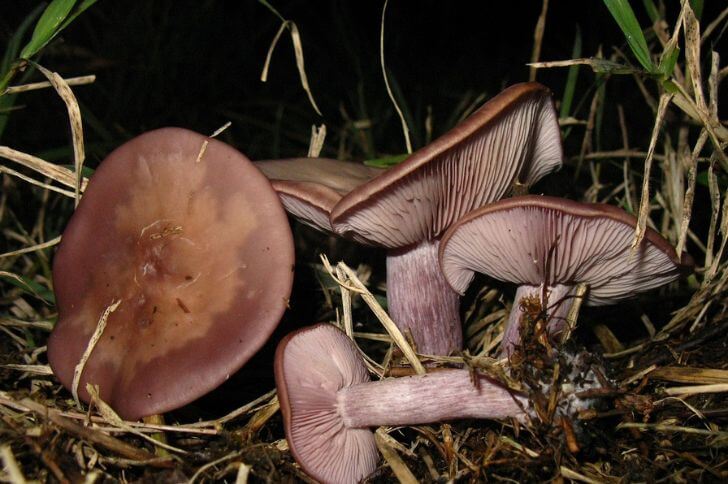
Wood Blewits or the lepista nuda are mushrooms that are a saprobic fungus, meaning that they feed on decomposing organic matter. These Ohio mushrooms can be identified by its purple-pink or lilac colors, with purplish gills.
The stem is also purplish with a distinctive frozen orange scent. The flesh of the Wood Blewit mushroom is white, and the taste is mild. This mushroom can be eaten fresh or cooked.
14. Honey mushrooms

What are honey mushrooms? Honey mushrooms are a genus of edible mushrooms that include over 100 species. The most popular variety is the Armillaria mellea.
These mushrooms have a sweet and nutty flavor, and can be eaten fresh or cooked. They are found in the wild and can be grown in home gardens.
What do honey mushrooms look like? They vary in color, but most are light brown or yellow.
They have a smooth, fleshy cap that is typically 1-3 inches in diameter, and a stem that is either smooth or has small ridges. The gills on the underside of the cap are white or light brown, and the mushroom’s spores are black.
15. Woolly chanterelle

This mushroom, known scientifically as Turbinellus floccosus and also locally known as scaly vase, is a member of the chanterelle family.
Woolly chanterelles can be identified by their orange color, wavy cap edge, and thick white stem. They are typically found in woodlands and grow on the ground near trees.
Woolly chanterelles have a mild flavor and can be eaten fresh or cooked. They are popular in recipes such as soups, sauces, and stews.
16. Smooth white lepiota
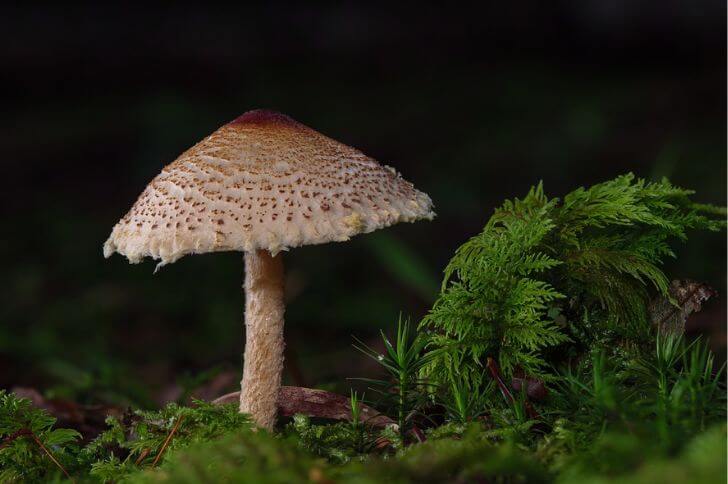
This beautiful, smooth white lepiota is a common sight in many areas of Ohio. It fruits from July to September and can be found growing in groups or singly on the ground in wooded areas.
The cap is 4-inch across, convex, and smooth with a white margin that often fades with age. The gills are white, close together, and have a decurrent tooth. The stem is also white, cylindrical, and smooth.
The taste of this mushroom is mild and its texture is slightly rubbery. It can be eaten raw or cooked and is best when young.
17. Hen-of-the-woods

Hen-of-the-woods, also known as maitake, is a polypore mushroom that grows on the ground in clusters. The mushrooms are white to light brown in color and have a velvety texture.
They are often used in cooking and can be eaten fresh or dried. Hen-of-the-woods has a mild flavor and a slightly crunchy texture. It is high in protein.
18. Black velvet bolete

Black velvet bolete is a striking and under-appreciated mushroom that can be found in late summer and fall. It has a distinctive, deep purple to black cap with a velvety texture, and white pores on the underside of the cap. The flesh is white, firm, and slightly bitter.
Despite its attractive appearance, the black velvet bolete is not commonly eaten due to its bitter taste. However, it can be used in place of portobello mushrooms in recipes.
The mushroom is best cooked slowly over low heat so that its flavor can shine through.
19. Peppery milk cap mushroom
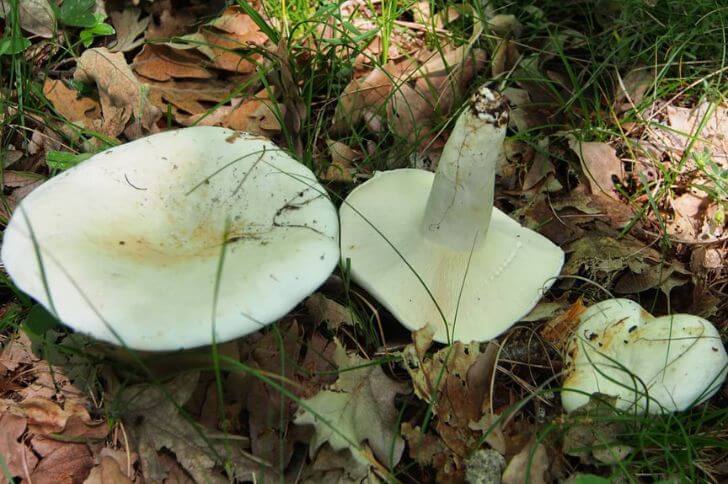
A peppery milk-cap or the Lactifluus piperatus is a type of edible Ohio mushroom. The mushroom has a cap that is about 2.5-6.5 inches in diameter, and a stem that is about 1-3 inches long.
The cap is typically white or cream-colored, but can sometimes be brownish. The stem is also white or cream-colored, and is sometimes slightly peppery to the taste.
20. Shaggy mane

Shaggy mane is a mushroom that grows in late summer and early fall. It can be found growing on the ground in woods and meadows, or on rotting logs.
The cap is rusty brown to gray, and can grow up to 8 inches wide with a shaggy look. The gills and stem are white. Shaggy mane mushrooms are edible, but some people find them tough to chew.
21. Gyromitra brunnea
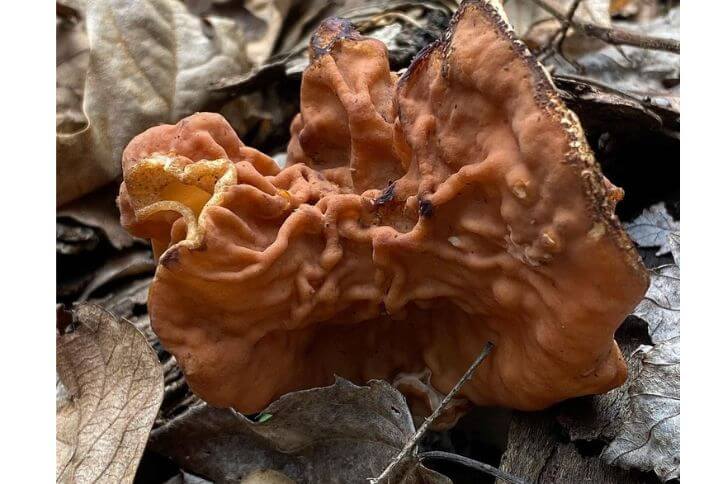
Gyromitra brunnea, more commonly known as the big red or false morel, is a type of mushroom that can be found in hardwood forests.
It is often mistaken for the true morel, but they are easily distinguishable by their shapes.
The false morel is taller and has a smoother, less wrinkled surface than the true morel. They are also generally darker in color than true morels.
False morels are edible, but they must be cooked properly to remove any toxins. They are often used in recipes for stuffing or gravy. They can also be dried and you can use them later.
22. Dryad’s saddle

Dryad’s saddle is a common, but easily overlooked, species of fungus found on the bark of trees and on dead wood.
It has a distinctly scaly cap that is brown to reddish-brown in color and can reach up to 12 inches diameter.
The gills are white to cream-colored and have a decurrent attachment to the stem. The spores are ellipsoid in shape.
23. Meadow mushroom
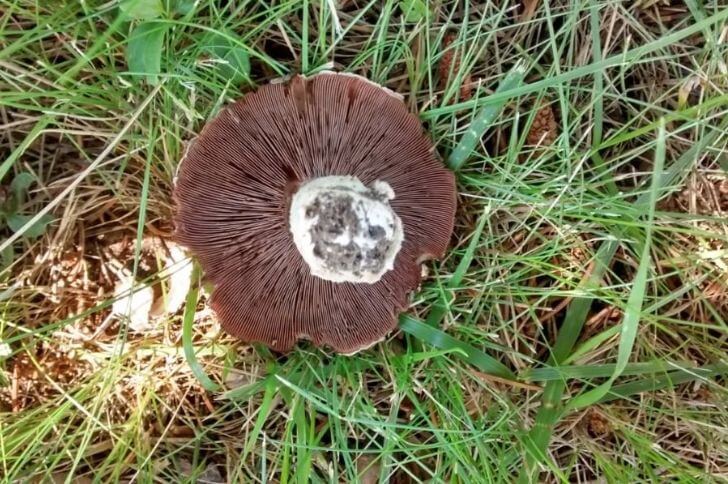
Meadow mushrooms can be identified by its white cap that can measure up to 4.5 inches in diameter, its pink gills, and its 3.8 inches long stipe.
These mushrooms taste best when fried or sauteed. You can also use them to make salads.
24. Russula mushroom
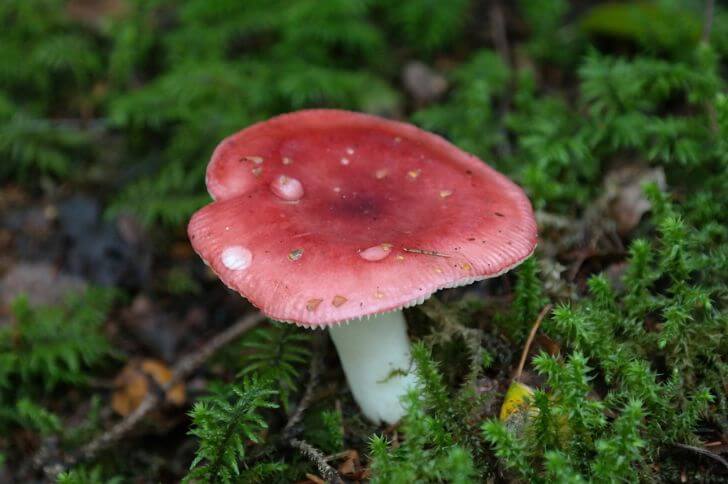
Russula mushrooms are types of edible mushrooms that are found in parts of ohio. There are many different types of Russula mushrooms, and they come in a variety of colors, including white, green, yellow, and red.
Russula mushrooms are considered to be some of the best tasting mushrooms around, and they are often used in recipes.
25. Ramaria aurea

Ramaria aurea is a coral mushroom that can be found in parts of North America including Ohio.
It has a yellow cap and stem, and can grow up to 12 inches tall. Ramaria aurea is edible, and has a fruity taste. It is best cooked lightly, as it can be tough if overcooked.
26. Hygrocybe miniata (Vermilion Waxcap)
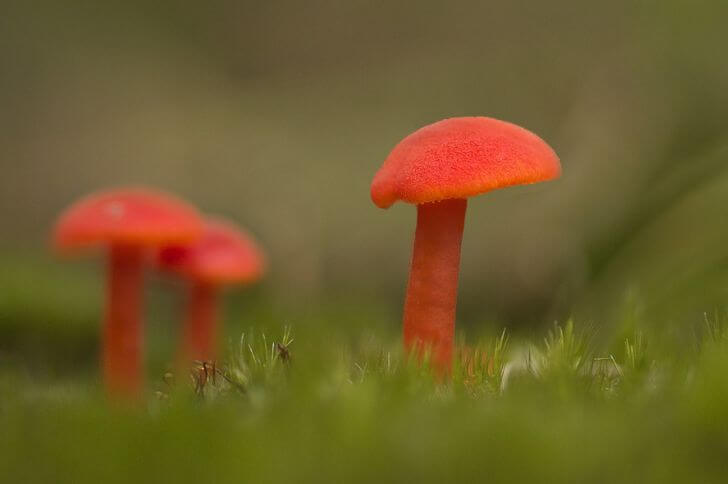
Hygrocybe miniata, also known as the vermilion waxcap, is a species of mushroom that has an orange-colored cap that is convex in shape when young, but becomes flattened with age.
The gills and stem are also orange. This mushroom is edible and we recommend you ensure it is well cooked.
27. Greville’s bolete
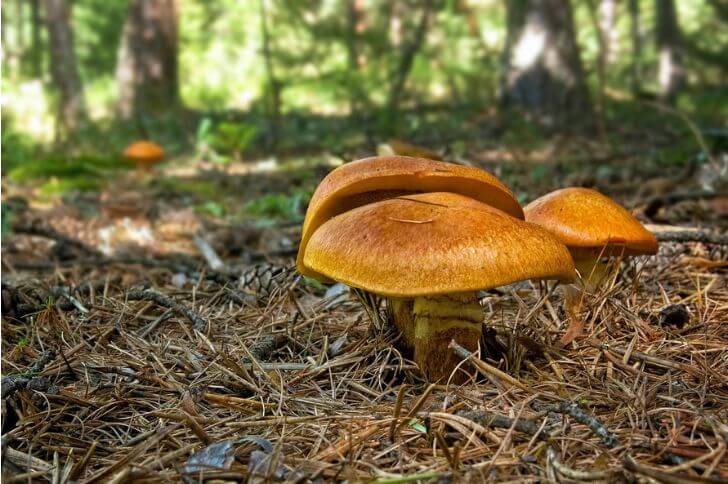
Greville’s bolete or the larch bolete is a fungus that grows in the summer and fall. It is a burnt brown color with a white pore surface.
The mushroom has a smooth, firm texture and a slightly bitter taste. It is found in deciduous forests and on the edges of coniferous forests.
Inedible Mushrooms of Ohio
28. Destroying angel

Destroying angel mushrooms are a deadly mushroom that looks strikingly similar to edible mushrooms.
They can be easily mistaken for the common field mushroom, or even the puffball, both of which are considered delicacies. The destroying angel contains toxins.
29. False morels

False morels look very similar to edible morels, but they contain toxins that can cause nausea. They are often mistaken for edible morels, so it’s important to know the difference between the two types of mushrooms.
False morels can be identified by their deep ridges and by their “brain-like” appearance.
They’re also usually a darker color than edible morels. If you’re not sure whether a mushroom is a false morel, it’s best to avoid eating it.
30. Jack-o-Lantern mushroom

Jack-o-Lantern mushrooms are a type of fungi that are characterized by their yellow-orange color.
The gills on the underside of the fruit body are paler and the stem is orange. Often mistaken for chanterelle mushrooms, they are inedible and should not be picked.
31. Bleeding fairy helmet

A bleeding fairy helmet, also known as a bleeding tooth fungus, is a type of mushroom that grows on the ground or on rotting wood.
The fungus gets its name from the red liquid that oozes from its gills. The liquid is not blood, but rather a type of latex that helps the fungus spread its spores.
Final Thoughts
In conclusion, mushrooms are a great addition to any Ohioan’s diet. They are low in calories and high in nutrients, making them the perfect food for people who are looking to stay healthy.
In addition, wild mushrooms are a versatile ingredient that can be used in a variety of dishes. So why not add some mushrooms to your next meal?
Sources:
https://www.mushroomexpert.com/puffballs.html
https://en.wikipedia.org/wiki/Cantharellus_cibarius
Hi There,
My name is Jenny. I’m the Chief Editor at Try Green Recipes and besides making yummy and healthy foods for my kids, grandkids, and friends. I’m new to the blogging world but I believe what I have to share is unique and will bring joy to your home. If you are adventurous and want try something tasty, let’s get started.

